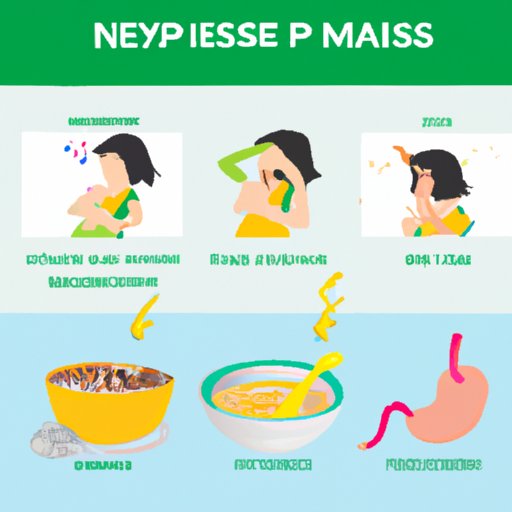Introduction
Nausea is a common symptom that can cause feelings of discomfort or queasiness in your stomach. It may be accompanied by vomiting, dizziness, sweating, or a feeling of faintness. While it’s usually not a serious condition, it can be uncomfortable and lead to loss of appetite or even dehydration if left untreated. In this article, we’ll discuss the causes of nausea, as well as some tips on how to get rid of it.
What Causes Nausea?
There are many potential causes of nausea. Some of the most common include motion sickness, food poisoning, medication side effects, and morning sickness. Let’s take a closer look at each of these.
Motion Sickness
Motion sickness occurs when your body senses movement but your brain does not. This can occur when riding in a car, boat, or plane, or when playing video games. Symptoms of motion sickness include nausea, dizziness, and vomiting.
Food Poisoning
Food poisoning occurs when you eat food contaminated with bacteria, viruses, or parasites. Symptoms can range from mild to severe, including nausea, vomiting, abdominal cramps, and diarrhea. If you think you have food poisoning, seek medical attention right away.
Medication Side Effects
Some medications can cause nausea as a side effect. This includes antibiotics, chemotherapy drugs, and certain pain medications. If you experience nausea after taking a medication, check with your doctor or pharmacist to see if it could be a side effect.
Morning Sickness
Morning sickness is a common symptom experienced during pregnancy. It typically begins around week 6 of pregnancy and can last up to the 16th week. Symptoms include nausea, vomiting, and dizziness. While there is no cure for morning sickness, there are ways to manage the symptoms.
How to Get Rid of Nausea
If you’re experiencing nausea, there are several things you can do to help get rid of it. Here are some of the most effective strategies:
Eat Bland Foods
Eating bland foods such as crackers, toast, and bananas can help settle your stomach and reduce nausea. Avoid greasy, fried, and spicy foods, which can make nausea worse.
Drink Clear Liquids
Staying hydrated is important when you’re feeling nauseous. Drink clear liquids such as water, apple juice, and ginger ale. Avoid caffeinated beverages, as they can make nausea worse.
Avoid Greasy, Fried, and Spicy Foods
Greasy, fried, and spicy foods can worsen nausea. Instead, opt for light, bland foods such as crackers, toast, and plain pasta.
Try Relaxation Techniques
Relaxation techniques such as deep breathing, progressive muscle relaxation, and visualization can help reduce feelings of nausea. These techniques can also help reduce stress and anxiety, which can worsen nausea.
Take an Over-the-Counter Antiemetic Medication
If your nausea persists, you may want to consider taking an over-the-counter antiemetic medication such as Dramamine or Bonine. Always read and follow the instructions on the label before taking any medication.
Apply a Cold Compress
Applying a cold compress to your forehead and temples can help reduce feelings of nausea. You can use a cold washcloth or a bag of frozen vegetables wrapped in a towel.
Conclusion
Nausea is a common symptom that can be caused by motion sickness, food poisoning, medication side effects, and morning sickness. To get rid of nausea, try eating bland foods, drinking clear liquids, avoiding greasy, fried, and spicy foods, trying relaxation techniques, taking an over-the-counter antiemetic medication, and applying a cold compress. With the right treatment, you can quickly get relief from your nausea.
(Note: Is this article not meeting your expectations? Do you have knowledge or insights to share? Unlock new opportunities and expand your reach by joining our authors team. Click Registration to join us and share your expertise with our readers.)
